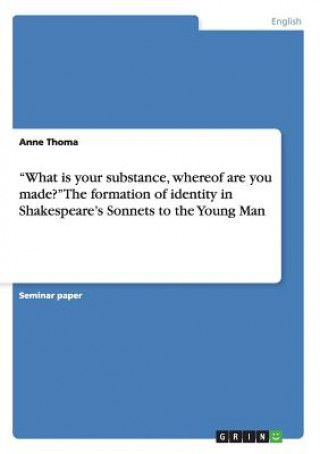
Livrare
Consilier de cumpărături





Nu se pretează? Nu contează! La noi puteți returna bunurile în 30 de zile
 Voucher cadou
orice valoare
Voucher cadou
orice valoare
Cu un voucher cadou nu veți da greș. În schimbul voucherului, destinatarul își poate alege orice din oferta noastră.
"What is your substance, whereof are you made?" The formation of identity in Shakespeare's Sonnets to the Young Man
 engleză
engleză
 102 b
102 b
30 de zile pentru retur bunuri


Seminar paper from the year 2006 in the subject English Language and Literature Studies - Literature, printed single-sided, grade: 1,0, University of Tubingen, course: Sonnet Cycles from the 16th to the 20th Centuries, 31 entries in the bibliography, language: English, comment: This text looks at Shakespeare's Sonnets in the light of an important Renaissance issue: It deals with identity and its various sources, focussing on the relationship of the poet and the young man. , abstract: Shakespeare s sonnets have often been discussed in terms of the degree of theirautobiographical content. The question what role the persons which the poet addresses, ayoung man and a dark woman, had actually played in the author s life sparked as much debateas the opaque initials W. H. , a dedication by Thomas Thorpe, who had published a Quartoby the title of Shakespeare s Sonnets. Never before imprinted in 1609 (Edmondson / Wells4). Some critics were led to conclude their research with triumphant statements such as Shakespeare s Sonnets. The Problems solved , a title employed by A. L. Rowse in 1964.Rowse claims to have spotted the identity of the young man, the dark lady, the rival poet, aswell as of W. H. . His edition of the sonnets also includes a chapter called The Story: itsOutlines (24).Other critics have been focussing less on a coherent story with identifiable characters. In theiranalysis, they often take a purely immanent stance and are more concerned with how the poet,the speaking voice of the sonnets, establishes an identity, a private subjectivity and sensibilityand in the course of his amorous encounters engages in a struggle to keep them afloat. I wantto argue along the lines of those researchers who put the previously rather central issues ofhomosocial desire and Platonic and Petrarchan love into the lager context of what StephenGreenblatt calls the self-fashioning of the Renaissance individual (1). He points out that the power to impose a shape upon oneself or another person is a major issue in the EnglishRenaissance, the age of the formation of identity (1 / 6). According to Colin Morris, therehad been distinctions between types and individual representation as early as 1020 (33 /65), but A. J. Piesse states that self-interrogation beyond a religious context began to loomonly at the beginning of the sixteenth century (634). In the 80s, Stephen Greenblatt andCatherine Belsey stressed that any formulation of identity must be seen in the light ofcultural context, that any exposition of self is a manifestation of a series of options, ratherthan something intrinsically different from anything else (Piesse 635). In his work Sources ofthe Self of 1989, Charles Taylor differentiates along the lines of Plato and Aristotle betweenthe importance of context and interior self for the individual (Ibid 635).
Informații despre carte
 engleză
engleză
Categorii




 Cum să cumpăr
Cum să cumpăr















